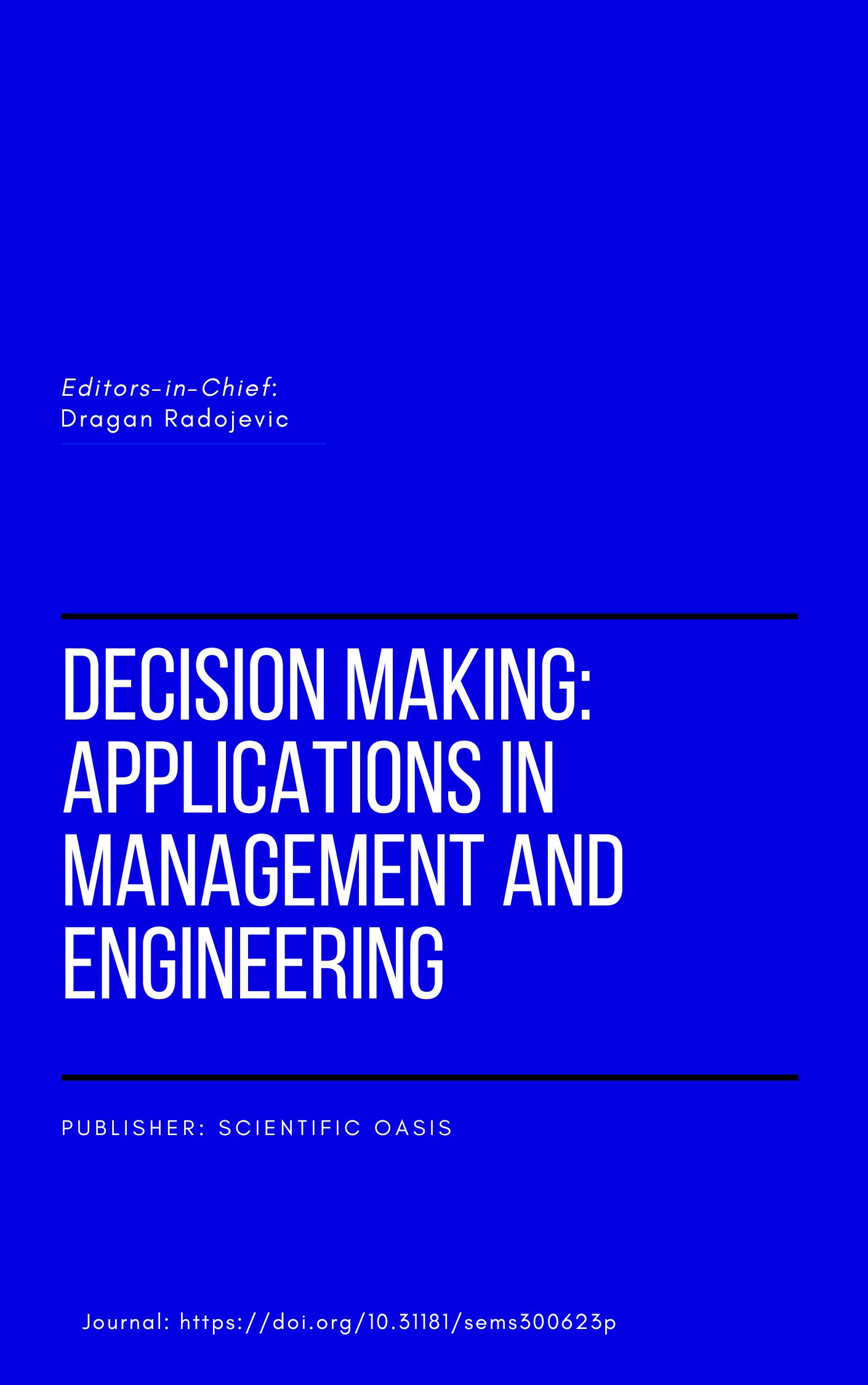Decision-Making Analysis for Sustainable Tourism Development: A DEMATEL and SEM Approach to Infrastructure and Policy Optimization in Ethnic Village Tourism
DOI:
https://doi.org/10.31181/dmame8120251382Keywords:
Decision-Making Models, DEMATEL, Sustainable Tourism Management, Infrastructure, Resource Allocation, Risk Management, Tourism Governance.Abstract
Achieving sustainable tourism development necessitates the utilisation of structured decision-making frameworks that effectively reconcile economic advancement, cultural heritage conservation, and infrastructural limitations. This research adopts the Decision-Making Trial and Evaluation Laboratory (DEMATEL) approach in conjunction with structural equation modelling (SEM) to pinpoint and assess the principal determinants influencing sustainable tourism within the context of strategic planning for ethnic village tourism. Focusing on the Xijiang Miao Village in China, the study incorporates semi-structured interviews and expert assessments to evaluate variables such as economic investment, infrastructure limitations, governance and managerial practices, cultural preservation efforts, and ecological sustainability. The analysis underscores the significance of multiple sub-elements associated with these core dimensions. Furthermore, through the application of SEM, the findings reveal that governance and policy (β = 0.222), alongside economic and resource management (β = 0.176), exert a favourable influence on sustainable development via enhanced strategic decision-making processes. Conversely, environmental and risk management (β = -0.804), infrastructure planning (β = -0.085), and the extent of stakeholder engagement in decision-making (β = -0.074) demonstrate adverse effects. This study enriches both qualitative and quantitative decision-support models by showcasing the integration of DEMATEL and SEM methodologies to refine strategic planning mechanisms in the realm of sustainable tourism. The insights derived are expected to guide key stakeholders, including governmental bodies, tourism authorities, and infrastructure developers, in formulating more effective policies and initiatives.
Downloads
References
[1] Adewale, T. T., Eyo-Udo, N. L., Toromade, A. S., & Ngochindo, A. (2024). Optimizing food and FMCG supply chains: A dual approach leveraging behavioral finance insights and big data analytics for strategic decision-making. Comprehensive Research and Reviews Journal, 2(1). https://doi.org/10.57219/crrj.2024.2.1.0028
[2] Olanrewaju, O. I. K., Daramola, G. O., & Ekechukwu, D. E. (2024). Strategic financial decision-making in sustainable energy investments: Leveraging big data for maximum impact. World Journal of Advanced Research and Reviews, 22(3), 564-573. https://doi.org/10.30574/wjarr.2024.22.3.1758
[3] Stone, M., Aravopoulou, E., Ekinci, Y., Evans, G., Hobbs, M., Labib, A., Laughlin, P., Machtynger, J., & Machtynger, L. (2020). Artificial intelligence (AI) in strategic marketing decision-making: a research agenda. Bottom Line, 33(2), 183-200. https://doi.org/10.1108/BL-03-2020-0022 DOI: https://doi.org/10.1108/BL-03-2020-0022
[4] Bousset, J. P., Skuras, D., Tesitel, J., Marsat, J. B., Petrou, A., Fiallo-Pantziou, E., Kusová, D., & Bartos, M. (2007). A decision support system for integrated tourism development: Rethinking tourism policies and management strategies. Tourism Geographies, 9(4), 387-404. https://doi.org/10.1080/14616680701647576 DOI: https://doi.org/10.1080/14616680701647576
[5] Unalan, D. (2013). Integrating cumulative impacts into strategic environmental decision-making: Tourism development in Belek, Turkey. Land Use Policy, 34, 243-249. https://doi.org/10.1016/j.landusepol.2013.03.014 DOI: https://doi.org/10.1016/j.landusepol.2013.03.014
[6] Hall, C. M. (2008). Tourism planning: Policies, processes and relationships. Pearson education. https://www.researchgate.net/publication/306088428
[7] Chase, L. C., Phillips, R. G., & Amsden, B. (2023). Stakeholder Engagement in Tourism Planning and Development. In M. Uysal & M. J. Sirgy (Eds.), Handbook of Tourism and Quality-of-Life Research II: Enhancing the Lives of Tourists, Residents of Host Communities and Service Providers (pp. 317-333). Springer International Publishing. https://doi.org/10.1007/978-3-031-31513-8_22
[8] Ruhanen, L. (2013). Local government: Facilitator or inhibitor of sustainable tourism development? Journal of Sustainable Tourism, 21(1), 80-98. https://doi.org/10.1080/09669582.2012.680463 DOI: https://doi.org/10.1080/09669582.2012.680463
[9] Raghavendra, D., Shilpa, V., & Vijayachandra Reddy, S. (2016). Determinants of tourism demand in India. International Journal of Humanities and Social Science Invention, 5(5), 20-26. https://www.ijhssi.org/papers/v5(5)/D0505020226.pdf
[10] Market Width (2019), “Tourism industry definition and composition. Is travel industry different or same as tourism industry?”, available at: http://www.market-width.com/Tourism-Industry.htm (accessed January, 2025).
[11] Zhuang, L., Taylor, T., Beirman, D., & Darcy, S. (2017). Socially sustainable ethnic tourism: a comparative study of two Hakka communities in China. Tourism Recreation Research, 42(4), 467-483. https://doi.org/10.1080/02508281.2017.1338817 DOI: https://doi.org/10.1080/02508281.2017.1338817
[12] Pu, D., Cao, Y., Hou, J., & Qiu, P. (2015). Development Strategic Research on Mountainous Ethnic Minority Beautiful Towns and Villages—Taking the Thousand Miao Villages Xijiang as Example. 3rd International Conference on Material, Mechanical and Manufacturing Engineering (IC3ME 2015), https://doi.org/10.2991/ic3me-15.2015.118 DOI: https://doi.org/10.2991/ic3me-15.2015.118
[13] You, & He. (2023). Research on Protective Development of National Cultural Resources Based on Barzel's Property Right Theory: A Case Study of Xijiang Qianhu Miao Village in Guizhou. Journal of Sociology and Ethnology, 5(1), 28-36. https://doi.org/10.23977/jsoce.2023.050106
[14] Hu, B., He, F., & Hu, L. (2022). Community Empowerment Under Powerful Government: A Sustainable Tourism Development Path for Cultural Heritage Sites. Frontiers in Psychology, 13, 752051. https://doi.org/10.3389/fpsyg.2022.752051
[15] Alinezhad, A., & Khalili, J. (2019). DEMATEL Method. In A. Alinezhad & J. Khalili (Eds.), New Methods and Applications in Multiple Attribute Decision Making (MADM) (pp. 103-108). Springer International Publishing. https://doi.org/10.1007/978-3-030-15009-9_15
[16] Timothy, D. J. (2002). Tourism and Political Boundaries. Routledge. https://doi.org/10.4324/9780203214480 DOI: https://doi.org/10.4324/9780203214480
[17] Baggio, R., Scott, N., & Cooper, C. (2010). Network science. A review focused on tourism. Annals of Tourism Research, 37(3), 802-827. https://doi.org/10.1016/j.annals.2010.02.008 DOI: https://doi.org/10.1016/j.annals.2010.02.008
[18] Yu, Y. (2023). The Existing Problems and Suggestions forthe Ethnic Village Tourism: ACase Study of Dong Village inZhaoxing. Communications in Humanities Research, 4, 478-485. https://doi.org/10.54254/2753-7064/4/20220715
[19] Peng ZhengBo, P. Z., & Wang FanFan, W. F. (2018). Rural social organizations in developing ethnic village tourism: a case study of old people's association in Xijiang Qianhu Miao Village. Tourism, Leisure and Sustainability. https://www.cabidigitallibrary.org/doi/full/10.5555/20193144965
[20] Liu, Y., Liang, J., Cao, Y., Yuan, J., & Li, X. (2022). Folk cultural tourism sustainable development strategy based on ROST CM6 text analysis——An Empirical Case of Xijiang Qianhu Miao Village. 2022 2nd International Conference on Business Administration and Data Science (BADS 2022), https://doi.org/10.2991/978-94-6463-102-9_20
[21] Astawa, I. P., Triyuni, N. N., & Santosa, I. D. M. C. (2018). Sustainable tourism and harmonious culture: A case study of cultic model at village tourism. Journal of Physics: Conference Series, 953(1). https://doi.org/10.1088/1742-6596/953/1/012057 DOI: https://doi.org/10.1088/1742-6596/953/1/012057
[22] Graburn, N. H. (1979). Ethnic and tourist arts: Cultural expressions from the fourth world. Univ of California Press. https://doi.org/10.2307/jj.13167979
[23] Wang, L., & Yotsumoto, Y. (2018). A different interpretation from Cornet's on tourism development in an ethnic minority village in China. Asia Pacific Journal of Tourism Research, 23(9), 847-861. https://doi.org/10.1080/10941665.2018.1492942
[24] Mathieson, A., & Wall, G. (1982). Tourism, economic, physical and social impacts. Longman, London. https://search.worldcat.org/title/7875731
[25] Yang, L., & Wall, G. (2009). Ethnic tourism: A framework and an application. Tourism Management, 30(4), 559-570. https://doi.org/10.1016/j.tourman.2008.09.008 DOI: https://doi.org/10.1016/j.tourman.2008.09.008
[26] Zhang, C.-H., Tang, J.-Y., & Wang, K.-Y. (2020). On Ethnic Village Tourism and Rural Development. Social Science, Education and Human Science. https://doi.org/10.12783/dtssehs/icesd2020/34443
[27] Bramwell, B. (1994). Rural tourism and sustainable rural tourism. Journal of Sustainable Tourism, 2(1-2), 1-6. https://doi.org/10.1080/09669589409510679 DOI: https://doi.org/10.1080/09669589409510679
[28] Fons, M. V. S., Fierro, J. A. M., & y Patiño, M. G. (2011). Rural tourism: A sustainable alternative. Applied Energy, 88(2), 551-557. https://doi.org/10.1016/j.apenergy.2010.08.031 DOI: https://doi.org/10.1016/j.apenergy.2010.08.031
[29] Su, B. (2011). Rural tourism in China. Tourism Management, 32(6), 1438-1441. https://doi.org/10.1016/j.tourman.2010.12.005 DOI: https://doi.org/10.1016/j.tourman.2010.12.005
[30] Wilson, S., Fesenmaier, D. R., Fesenmaier, J., & Van Es, J. C. (2001). Factors for success in rural tourism development. Journal of Travel Research, 40(2), 132-138. https://doi.org/10.1177/004728750104000203 DOI: https://doi.org/10.1177/004728750104000203
[31] Yang, L. (2011). Ethnic tourism and cultural representation. Annals of Tourism Research, 38(2), 561-585. https://doi.org/10.1016/j.annals.2010.10.009 DOI: https://doi.org/10.1016/j.annals.2010.10.009
[32] Chen, P., & Ye, X. (2019). Experience in Qiandongnan: Discussion on the protection and development path of traditional villages. 4th International Conference on Contemporary Education, Social Sciences and Humanities (ICCESSH 2019), https://doi.org/10.2991/iccessh-19.2019.356 DOI: https://doi.org/10.2991/iccessh-19.2019.356
[33] Zou, D. (2024). Impact of Perception, Satisfaction, and Penetration Rate of Commercial Cultural Tourism on the Sustainable Development of Intangible Cultural Heritage: A Case Study of Xijiang Miao Village in China. Trends in Sociology, 2(1), 1-20. https://doi.org/10.61187/ts.v2i1.60
[34] Si, S. L., You, X. Y., Liu, H. C., & Zhang, P. (2018). DEMATEL Technique: A Systematic Review of the State-of-the-Art Literature on Methodologies and Applications. Mathematical Problems in Engineering, 2018(1), 3696457. https://doi.org/10.1155/2018/3696457 DOI: https://doi.org/10.1155/2018/3696457
[35] Shieh, J. I., Wu, H. H., & Huang, K. K. (2010). A DEMATEL method in identifying key success factors of hospital service quality. Knowledge-Based Systems, 23(3), 277-282. https://doi.org/10.1016/j.knosys.2010.01.013 DOI: https://doi.org/10.1016/j.knosys.2010.01.013
[36] Hogarth, R. M. (1978). A note on aggregating opinions. Organizational Behavior and Human Performance, 21(1), 40-46. https://doi.org/10.1016/0030-5073(78)90037-5 DOI: https://doi.org/10.1016/0030-5073(78)90037-5
[37] Luthra, S., Garg, D., & Haleem, A. (2016). The impacts of critical success factors for implementing green supply chain management towards sustainability: An empirical investigation of Indian automobile industry. Journal of Cleaner Production, 121, 142-158. https://doi.org/10.1016/j.jclepro.2016.01.095 DOI: https://doi.org/10.1016/j.jclepro.2016.01.095
Downloads
Published
How to Cite
Issue
Section
License
Copyright (c) 2025 Decision Making: Applications in Management and Engineering

This work is licensed under a Creative Commons Attribution 4.0 International License.












